The Hum and Monthly Temperature Anomaly in Wales by Dr Chris Barnes, Bangor Scientific and Educational Consultants, e-mail doctor.barnes@univ.bangor.ac.uk first Published on-line November 2013, Revised February 2015.
Abstract
The
nature and possible causes of the magneto-acoustic phenomenon known as the Hum
are briefly summarised. Outbreaks of the Hum seem to coincide with certain
lunar tides. The number of days with strong subjective levels of Hum have been
plotted against known monthly temperature anomalies for Wales in the period
2006-2013. Although there is a suggestion
that Hum prevalence and increasing positive temperature anomaly are positively
associated, the quadratic form requires further investigation. Otherwise it
would seem that when Hum events increase beyond a certain threshold cooling
ensues. At first sight, a very unusual
relationship is seen, with the temperature anomaly versus days of Hum slope
seemingly changing monthly on an almost random basis. However, closer
investigation shows a sinusoidal fit with month over the entire 7 year period.
The indication is therefore there must be a real physical basis to the effect.
There are several geo-physical and metrological parameters which show similar
cyclic behaviours. Of those considered, the one with statistically highest
relevant regression coefficient of 0.95 was for arctic cloudiness. Thus the
slope of the arctic cloudiness curve might thus be used to predict whether the
frequency of Hum events causes an increase or decrease in local temperature and
accounts for why increased frequency of Hum events is apparently associated
with local warming in some months and cooling in other months. Arctic
cloudiness, particularly the type of cloud known as marine boundary layer cloud
is thought to be of critical importance in controlling global climate. There
have been various proposals regarding geo-engineering by salt injection to
artificially whiten clouds in this region. Increased shipping may already be
producing a favourable negative climate forcing feedback process along these
lines. Similarly, increased air traffic in arctic regions may have an effect.
However, the cloud edge heights have recently been shown to be governed by
space weather and atmospheric electricity. Further, the height of the clouds determines
their temperature, which then determines how much energy they radiate.
High-level clouds are cold and radiate little heat into space; instead, they
reflect heat radiation back towards Earth’s surface, warming the atmosphere and
magnifying the greenhouse effect. Low-level clouds, on the other hand, being
more compact and warmer, emit more heat radiation into space than back towards
Earth. They act as a parasol, reflecting sunlight and thus cooling Earth’s
surface. A cloud’s altitude, therefore, determines its effect on the climate.
Cloud altitude can change due to ionosphere-atmosphere coupling following
electron precipitation as a result of magnetic storms and sub storms and cosmic
ray interactions. Power systems on earth and powerful radio transmitters on
earth, candidates for involvement in the Hum can also cause inadvertent or planned
ionospheric heating and electron precipitation and hence
coincident cloud altitude changes. Sulphate Aerosol injected by aircraft
contrails also disturbs the global electric circuit and will thus be expected
to cause similar cloud height changes.
In other words by using a combination of radio and aerosol technology, weather control ought not to be a myth but a definite reality. Further studies will be used to see if the Hum can be used as a medium term weather forecaster.
Introduction
The Hum is a term given to a little known phenomenon which may be acoustic, magneto-acoustic or gravito-acoustic. There is even the possibly that the Hum could be a group of phenomena which behave in both as if it/they were simultaneously anthropogenic and preternatural. The Hum may conceivably be heard/perceived by between 2-11% of the World’s population. Those afflicted hear/perceive an irritating, sleep disturbing, yet often very subliminal, noise often described as like a misfiring idling diesel engine and mainly heard in buildings at night. The Hum has been tone matched at between 30-80 Hz with superimposed quasi-periodic modulations of .5-5Hz. This description of the noise is also associated with that described for infrasound, see Moller and Pederson (2004) [1].
Because the first American Hum, namely the Taos Hum could not be audio recorded, the Hum has, over the years, taken on somewhat of a mysterious guise.
The Hum was first reported in Britain in the 1970’s and in the USA in the 1990’s. Originally, some suggested that the Hum was associated with Western Military Defence systems since it was not reported in the former USSR or China. A minority of cases of the Hum have been solved or rather attributed to sources of infrasound, acoustic sound and vibration such as volcanic action on Hawaii or the Kokomo hum was due to industrial sources.
Generally however the Hum appears to behave as though it were far more than just a noise and the majority of cases are rarely, if ever solved. Recently there have been cases of the Hum all over the World including in Russia and China and by using meta-analysis it seems that the more contemporary Hum is geographically most associated with modern, renewable and smart grid style, energy infrastructure [2]. Some have also tried associating the Hum with high pressure gas mains but Russia had these long before the Hum was reported there. Careful treatment of all known anecdotal reports of the Hum’s characteristics is suggestive that it may be a magneto-acoustic phenomenon and that some individuals may perceive it by senses in addition to just audition [3].
Modern electricity infrastructure can be a source of infrasound, acoustic sound, impulsive noise and electromagnetic energy at fundamental, sub-harmonic, inter-harmonic and harmonic and provide inter-area and intra-area quasi-period oscillations and even microwave frequencies (for control and monitoring) and all or any of these various components are capable under certain circumstances of being coherently or quasi-coherently related to each other. It is perhaps thus this feature of power systems which might make the 21st Century Hum so pervasive.
Hydro-power and pumped storage turbines are perhaps the most obvious source for a seismic component of Hum associated with renewable energy. Power pylons, sub stations and wind turbines are perhaps the most obvious sources for acoustic and infrasonic sources of the Hum. Infrasound and seismic sound of natural atmospheric and lithospheric origin may also become anthropogenicaly modulated and vice versa.
Additionally, there is by exhaustive observation, somehow, a link between the Hum and the Earth’s geomagnetic parameters. This is certain as it has been shown that the Hum maximises under certain sets of geomagnetic conditions [4]. The logical conclusion is that somehow the presumed power systems signals either modulate natural geomagnetic signals or vice versa to produce the Hum. This is not unlike the effect of ionopsheric heating which is not simply limited to intentional systems such as HAARP and SURA but actually also happens as a consequence all high power domestic broadcast transmitters (see for example, but not limited to, Cannon et al 1982) [5] and for power line harmonic radiation, see Park and Helliwell(1978) [6] Such modulation could be possible in space i.e. the ionosphere, in the atmosphere or in the lithosphere or in all three. The latter is likely as they are all intimately coupled by both the geo-electric circuit and by acoustic gravity wave (AGW) interactions. AGW and electric circuit are associated with the weather. There are many anecdotal reports of Hum being associated with the weather, with wind, with rain, with jet streams, with high and low pressure systems but many lack consistency. It is of course very well known that power systems can be damaged by strong geo-magnetic storms.
The present author has previously shown that although the Hum is associated with periods of geomagnetic activity there are very specific periods within this activity associated with equal and opposite electrojet currents which maximise the Hum [7].
There are only two possible reasons for this. Firstly, injection of anthropogenic signals into the ionosphere might be easier. Secondly, there may be less random seismic noise under these conditions, see Wilson (2005) [8] allowing the Hum seismic component to propagate more easily. Modern earth science is producing more and more intimate links between atmosphere, lithosphere, global electric circuit, geomagnetism , solar and lunar behaviour, weather and climate, see for example but not limited to Amory-Mazaudier [9].
It has been known since the 1960’s that the moon is a modulator of geomagnetic activity on earth, see Bigg (1963), Stolov and Cameron (1964) [10] and Bell and Defouw (1966) [11]. Lethbridge (1970) [12] showed that the moon declination influenced total thunderstorm activity. One assumes there is a connection here with both geo-magnetism and the global electric circuit. Of course thunderstorms also generate infrasound and AGWS.
Much more recently, Fejer and Tracer have considered lunar tidal effects in the electrodynamics of the low latitude ionosphere which they have shown can be highly variable even in geomagnetically quiet times. Lunar tides over periods of hours can play a significant part in this variability. Interestingly, outbreaks of the Hum can last for several hours and coincide with east /west cancelation in the electrojet current streams, see Barnes [7].
Zurbenko and Potrzeba (2013) [13] discuss the wider issue of atmospheric tides of both lunar and solar origin in far more detail. They conclude the significance of such tides is far greater than previously anticipated in many events in the atmosphere. Perhaps even more reason to assume the moon and the Hum ought to be connected then? Lunar phase even has a small but statistically significant effect on daily global temperature; see Balling and Cerveny (1995) [14].
Adjunctively to this there will be gravitational effects of the moon on atmospheric tides and hence on seismic signal propagation, particular prior to major earthquakes for example see Hayakawa et al (2009) [15].
The present author has recently confirmed that lunar behaviour can be a predictor of the Hum so the question is posed here is can the Hum predict weather anomaly or vice versa.
Experimental
The experimental subjects are the author and his wife. Although both describe the same Hum, the author’s wife generally perceives its return after a quiet period some 48-72h prior to the author. The average data set from both subjects is for the whole of 2013 to date making a purely subjective scale for the Hum as being 0 = not perceptible, 2= weak, 5= moderate and 10=strong (hard to screen). The number of days with subjective levels for various ‘Hum events’ of ‘5’ and greater across the have been plotted against known monthly temperature anomalies f or Wales in the period 2006-2013.
A well-known freeware curve fitting routine (Hyams) [16] was employed.
Results and Discussion
Figure 1 below, shows the temperature anomalies for Wales in the period 2006-2013, plotted against number of days with subjective levels for various ‘Hum events’ of ‘5’ and greater
with
a quadratic fit. 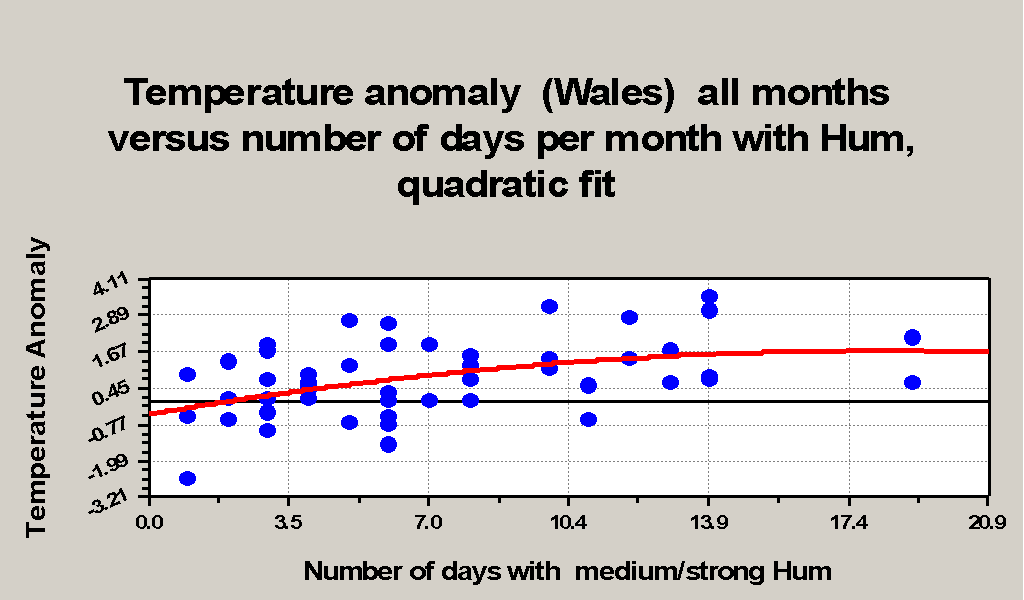
Although there is a suggestion that Hum prevalence and increasing positive temperature anomaly are positively associated, the quadratic form requires further investigation. Otherwise it would seem that when Hum events increase beyond a certain threshold cooling ensues.
In order to see if this trend is across the entire year for each and every year in the series, individual monthly data has been examined.
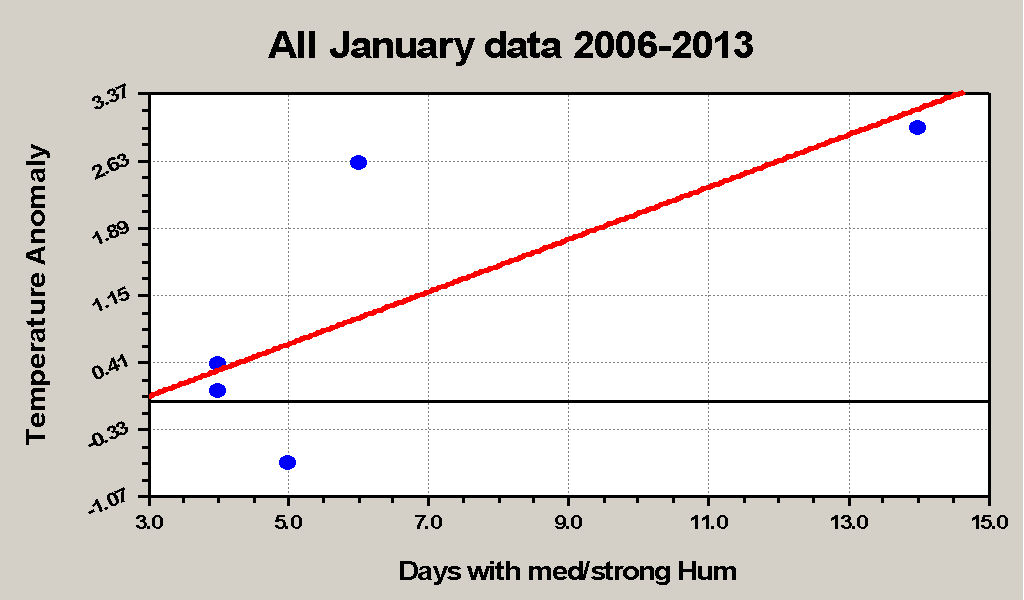
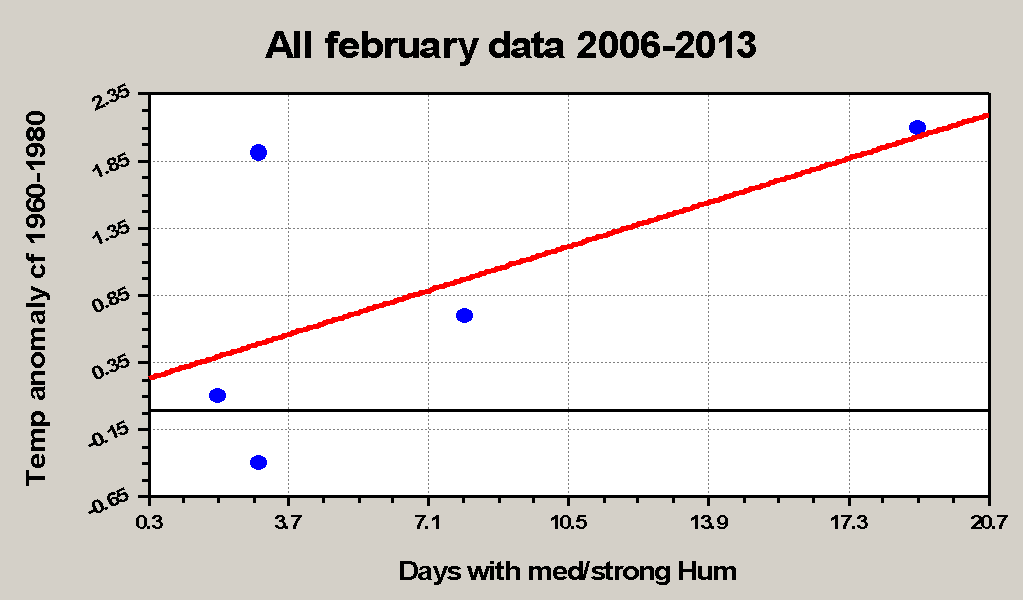
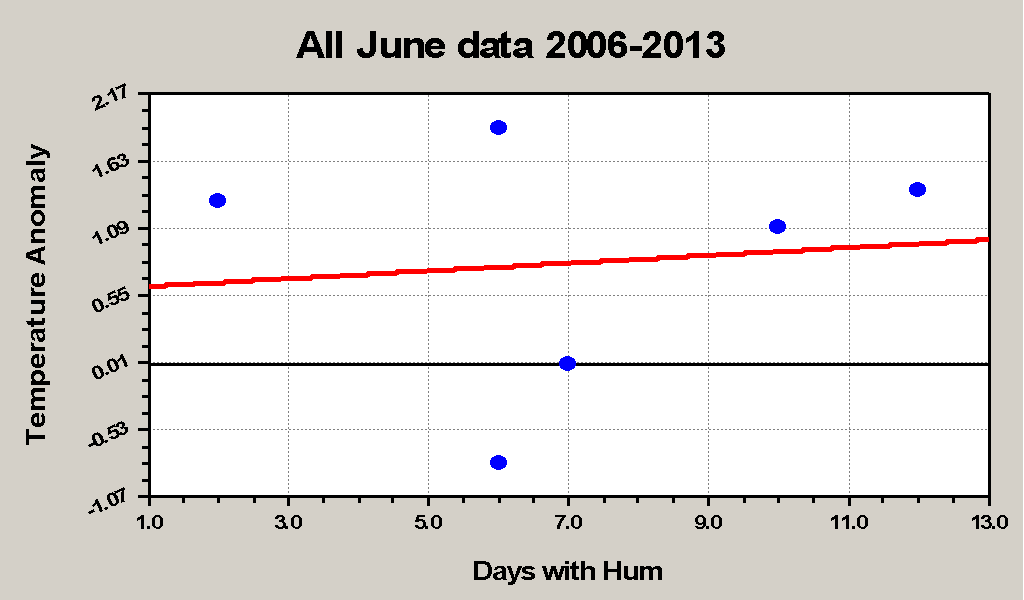
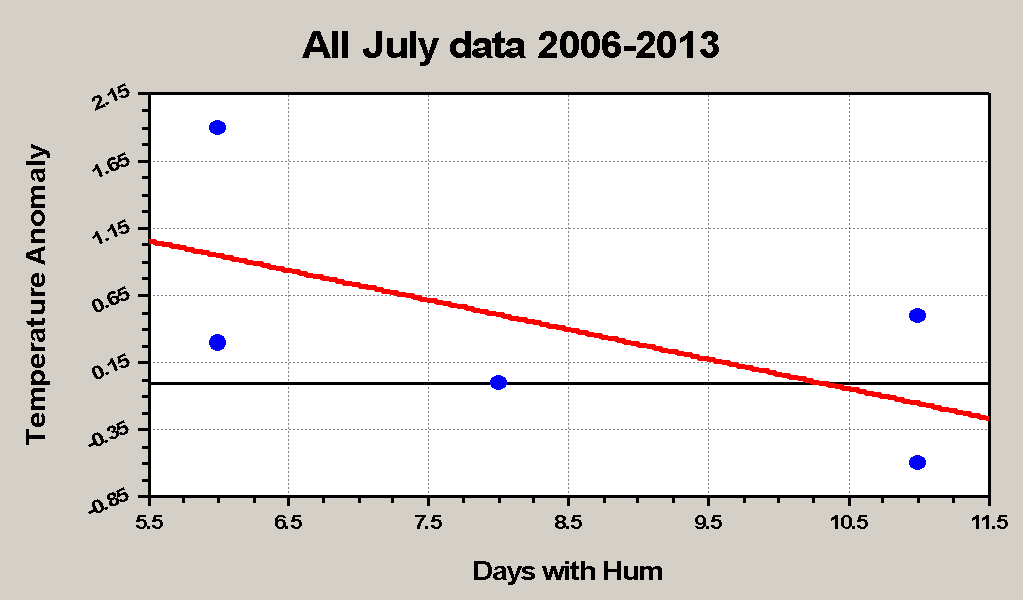
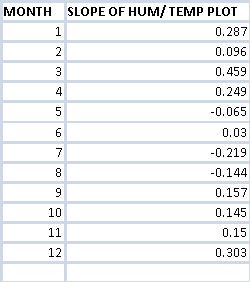
At first sight very unusual relationship is seen with the temperature anomaly versus days of Hum slope seemingly changing monthly on an almost random basis.
However closer investigation shows a sinusoidal fit with month over the entire 7 years period. The indication is therefore there must be a real physical basis to the effect.
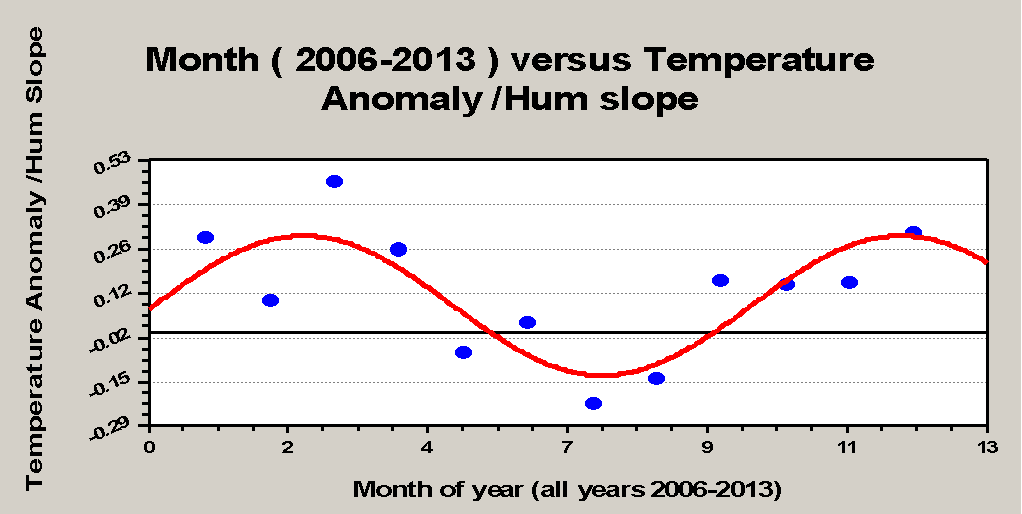
There are several geo-physical and metrological parameters which show similar cyclic behaviours. These are namely; sea ice area, sea ice mass and a large number of atmospheric gases and pollutants. The anomaly parameter was regressed against several of these as potential associated/driving factors in an effort to gain a better understanding of the processes involved and the regression factors were noted. A regression coefficient of 0.76 was obtained for Arctic Sea Ice and for SO2. A regression coefficient of .86 was obtained for Photo-decay of CO2. A lower value regression coefficient of .072 was obtained for sea temperature.
However, a statistically very relevant regression coefficient of 0.95 was obtained for arctic cloudiness.
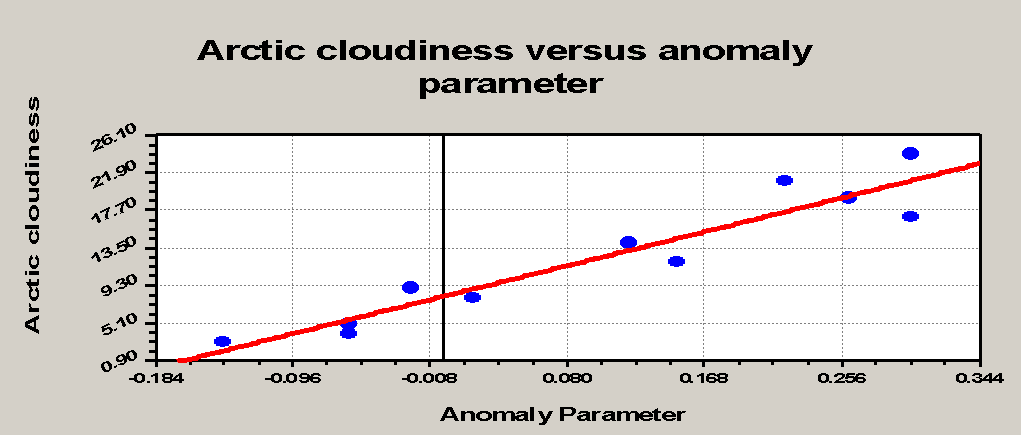
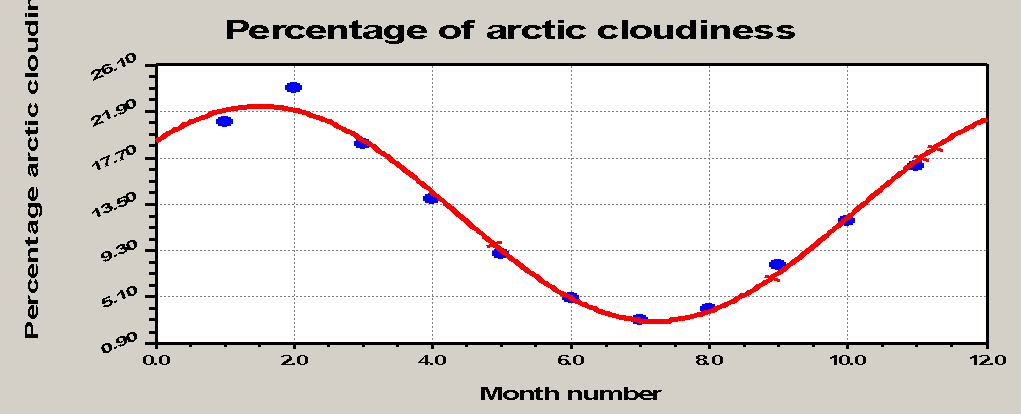
Thus the slope of the arctic cloudiness curve might thus be used to predict whether the frequency of Hum events causes an increase or decrease in local temperature and accounts for why increased frequency of Hum events is apparently associated with local warming in some months and cooling in other months.
Arctic cloudiness, particularly marine boundary layer cloud is thought to be of critical importance in controlling global climate. So critical indeed, that there have even been various proposals regarding geo-engineering by salt injection to artificially whiten clouds in this region. Increased shipping may already be producing a favourable negative climate forcing feedback process along these lines. Similarly increased air traffic in arctic regions may have an effect.
However, the critically important fact here is the fact
that cloud edge heights have recently
been shown to be governed by space weather and atmospheric electricity with a
1% change in fair weather electric current causing a very consistent 4m change
in cloud edge height (see Nicoll and Harrison 2011).
The height of the clouds determines their temperature, which then determines how much energy they radiate. High-level clouds are cold and radiate little heat into space; instead, they reflect heat radiation back towards Earth’s surface, warming the atmosphere and magnifying the greenhouse effect. Low-level clouds, more compact and warmer, emit more heat radiation into space than back towards Earth. They act as a parasol, reflecting sunlight and thus cooling Earth’s surface. A cloud’s altitude, therefore, determines its effect on the climate.
Cloud altitude can change due to ionosphere-atmosphere coupling following electron precipitation as a result of magnetic storms and sub storms and cosmic ray interactions, see Kleimenova et al, Russian Inst. of Geophysics and for a more recent confirmation of this see Harrison and Ambaum (2013) [17]. Global atmospheric electricity exhibits a daily cycle, hitting a minimum at around 03:00 GMT and peaking at roughly 19:00 GMT – when activity is high in thunderstorm hotspots such as Africa and North America. Interestingly, people report the Hum maximising in the small hours of the morning corresponding to the above minimum. I would expect an anthropogenic modulation of a natural phenomenon to maximise exactly in this manner and I have referred to this elsewhere with respect to the East West electrojet effect.
Power systems on earth, candidates for involvement in the Hum can cause inadvertent ionospheric heating and electron precipitation and indeed global atmospheric changes as significant as thunderstorms , see for example, but not limited to Prakash et al (2009) [18] and hence I would also expect them to cause cloud altitude changes.
Similarly, powerful radio transmitters such as HAARP and
SURA are intentionally designed to bring about such heating and electron
precipitation, see Kuznetsov and Ruzhin (2014) [19].
Although the intended original purpose
of these systems was to modify ionosphere radio communication channels and
possibly mitigate the effects of Solar flares on radio communication systems.
Many of the successful attributes of HAARP and the like have been summarised by
Leyser and Wong (2009) [20], but such systems will
also be expected to alter cloud heights as explained above and cause attendant
weather modification, however great or small. Another missing driver in the climate system
also recently discovered is the way in which electron precipitation impacts mesospheric
ozone, see Andersson et al (2014) [21]. Another
missing driver is that AGW interactions are a two way street as I have
explained elsewhere [22]. The question I
pose is one for others to answer. Namely, is this modification inadvertent or
is it intentional? I first pointed
this possibility out to a so- called Cloud Parameterization Expert in the UK
Met Office some 10 YEARS AGO!! (Personal Communication). I got
the impression I was being not only disbelieved but ridiculed too. Now the rest of the Science is firmly in the
public domain maybe I am deserved an
apology and it is time someone should listen.
Sulphate Aerosol injected by aircraft contrails also disturbs the global electric circuit and will thus be expected to cause similar cloud height changes. So by implication aircraft too can be used to inadvertently or intentionally control aspects of weather and climate.
One other very important questions arise:
1. Could frequency of Hum events be used predicatively to predict short or medium term temperature rises?
Further work
It will be the aim of a further brief publication in this series to explore the first question posed above.
References
(full list added
February 2015)
2.
http://www.drchrisbarnes.co.uk/HUMGRIDEFO.htm
3.
http://www.drchrisbarnes.co.uk/HUMUNIFY.htm
4.
http://www.drchrisbarnes.co.uk/geomag.htm
5.
http://www.sciencedirect.com/science/article/pii/0021916982900368
6.
http://nova.stanford.edu/~vlf/publications/209.pdf
7.
http://www.drchrisbarnes.co.uk/MOON2.html
9.
https://hal.archives-ouvertes.fr/hal-00968686/document
10. http://ntrs.nasa.gov/archive/nasa/casi.ntrs.nasa.gov/19650014511.pdf
11. http://onlinelibrary.wiley.com/doi/10.1029/JZ071i019p04599/abstract
12. .
Journal of Geophysical Research, 68, 99-104. LETHERIDGE, M. D. (1970)
13. http://link.springer.com/article/10.2478/s11600-009-0049-y#page-1
14. http://www.sciencemag.org/content/267/5203/1481.short
15. http://www.nat-hazards-earth-syst-sci.net/9/1733/2009/nhess-9-1733-2009.html
16. CurveExpert 1.4 Daniel Hyams
17. http://iopscience.iop.org/1748-9326/8/1/015027/pdf/1748-9326_8_1_015027.pdf
18. http://nopr.niscair.res.in/bitstream/123456789/4013/1/IJRSP%2038%282%29%2074-79.pdf
19. Anthropogenic
trigger of substorms and energetic particles
precipitations, Advances in Space Research
, Volume 54, Issue 12, 15 December 2014, Pages 2549–2558 http://www.sciencedirect.com/science/article/pii/S0273117713006492
20. http://onlinelibrary.wiley.com/doi/10.1029/2007RG000235/full
21. http://www.nature.com/ncomms/2014/141014/ncomms6197/full/ncomms6197.html
22. Global Climate Change, natural, inadvertent
and planned controls some unsung concepts.
By Dr Chris Barnes, Bangor Scientific and Educational Consultants. E-mail scienceconsultants@yahoo.co.uk Internet Publication December 30th
2012 Revised 1st January 2013 http://www.drchrisbarnes.co.uk/Global.htm
References revised February 2015.